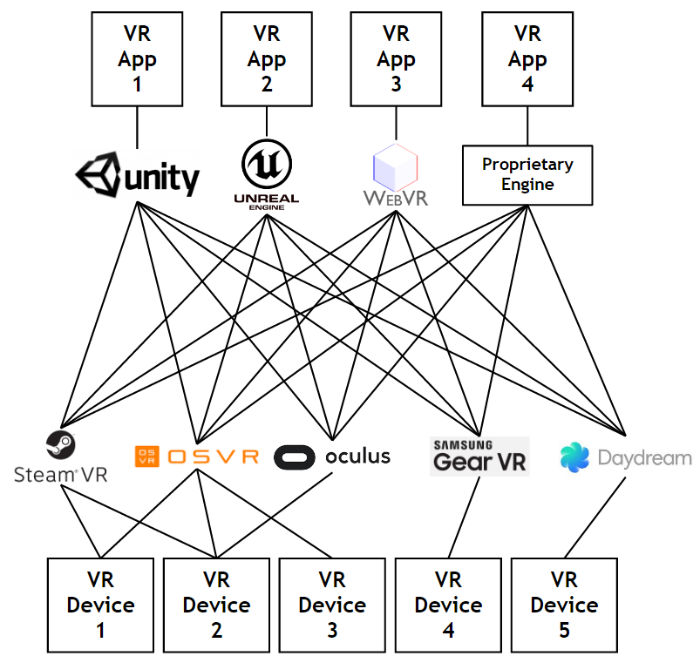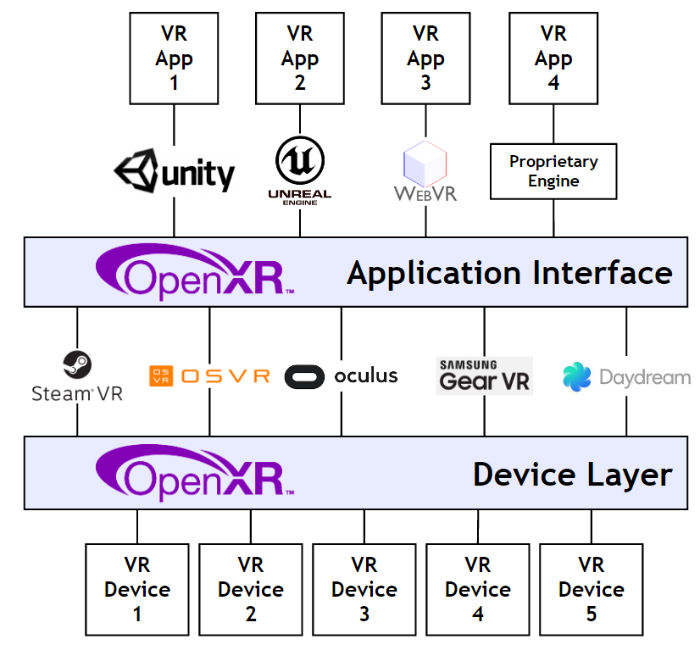Khronos Bolsters VR, AR, MR Markets With OpenXR Working Group, API Updates, More
The Khronos Group announced a new standard, OpenXR, that's meant to help VR and AR game developers support more hardware platforms with less hassle. The consortium also revealed updates to Vulkan, WebGL, and glTF as well as new working groups devoted to developing these standards. With support from Intel, Oculus, and many other companies, the announcements promise to shake up XR game development as we know it.
OpenXR
OpenXR is the official name for the open standard that was originally announced as the Khronos VR Initiative in December 2016. It's supported by a working group consisting of many companies, ranging from Oculus and Nvidia to Google and Intel, and its goal is to make cross-platform VR development easier. Here's what supporting multiple VR platforms looks like now, according to Khronos:
The OpenXR standard is supposed to make that process look more like this:
That requires support from many companies--which is exactly what this OpenXR working group has. In addition to the members announced in December, the group is now supported by Qualcomm, Sony, and other companies involved in various aspects of XR development. Chip makers, game engine creators, and the companies behind the consumer VR platforms that took the world by storm in 2016 are all part of this growing consortium.
Still, there's no word on when the OpenXR standard will debut. Khronos is known for taking its time with new standards or APIs; the Vulkan API released in early 2016, for example, was in development for a year before it was made available to the public. Given the complexity involved with OpenXR's mission and the need to coordinate between many different companies, VR and AR game development will probably remain complicated for a while.
Updates To Vulkan, WebGL, glTF
Speaking of Vulkan: Khronos announced that the API, which is meant to compete with AMD's Mantle, has been updated with new features "for cross-platform access to Virtual Reality and multi-GPU functionality." The group also said that a dozen Vulkan-compatible titles, such as Doom, The Talos Principle, and Dota 2, are now available, and that "major GPU manufacturers" are shipping Vulkan drivers for both desktop and mobile systems.
Khronos also finalized the WebGL 2.0 standard so devs can "create the next wave of 3D web applications and engines." It's working on the next generation of WebGL and seeking feedback on the glTF 2.0 specification, with hopes of finalizing the update in "the next few weeks." The first version of glTF was devoted to "enable 3D assets to be shipped to, and efficiently loaded by, WebGL 1.0 applications." The second iteration has a broader goal:
Get Tom's Hardware's best news and in-depth reviews, straight to your inbox.
But glTF 2.0 is much more than a streamlining of glTF 1.0. The major functionality requests arriving from the developer community using glTF 1.0 were to: a) upgrade the quality of materials; while b) removing any dependency on the underlying rendering API. In glTF 1.0, a material is defined with a GLSL shader – which causes an issue when wanting to import a glTF model into a Direct3D, Vulkan or Metal application. Fortunately, there is a technology that can solve both these problems in one stroke – Physically Based Rendering (PBR). A PBR material is defined by simply sending parameters into a well-defined rendering model.
All of these updates should help developers create XR experiences without ripping their own hair out.
More At GDC 2017
Khronos plans to discuss OpenXR, Vulkan, WebGL, glTF, and more throughout GDC 2017. The group's full schedule can be found on its website, but these are the highlights:
Khronos GDC Booth – Visit the Khronos booth for hourly presentations on Khronos APIs as well as opportunities to talk with Khronos members and standards experts. Booth 2419, South Hall.Khronos discusses OpenXR at VRDC 2017: Monday and Tuesday, February 27 to 28 from 10 a.m. to 6 p.m., visit the Khronos table #TT06 in room 135 North Hall to talk to VR experts working on OpenXR and share feedback on this recently-announced initiative.Khronos 3D Graphics Developer Day Sessions on Vulkan, OpenXR, WebGL, glTF and more: On Tuesday, February 28 from 10 a.m. to 6 p.m., room 3022 in West Hall, Khronos will host one-hour educational sessions for developers.Khronos Meetup: To discuss WebGL, WebVR, glTF, mobile 3D and network with Khronos members and developers, join the group on Thursday, March 2 from 6:30 p.m. to 9:30 p.m. at Galvanize, San Francisco.Official GDC Sessions related to Khronos standards: Khronos members and developers will present on topics from Vulkan Lessons Learned to the Future of VR.

Nathaniel Mott is a freelance news and features writer for Tom's Hardware US, covering breaking news, security, and the silliest aspects of the tech industry.
-
bit_user ReplySpeaking of Vulkan: Khronos announced that the API, which is meant to compete with supersede AMD's Mantle,
Fixed that, for you. -
bit_user Reply
Is there a standard for PBR shaders? Surely, they're going to be less efficient than many of the simpler shaders out there, and not amenable to some of the hacks that employ shaders to accomplish various special effects.In glTF 1.0, a material is defined with a GLSL shader – which causes an issue when wanting to import a glTF model into a Direct3D, Vulkan or Metal application. Fortunately, there is a technology that can solve both these problems in one stroke – Physically Based Rendering (PBR). A PBR material is defined by simply sending parameters into a well-defined rendering model.
I'm really skeptical that textures can be adequately modeled as PBR shaders, but perhaps someone can educate me.
IMO, they should've just used SPIR-V. Microsoft might whine about that, but it shouldn't be hard for them to support (all of the supported GPUs already implement it).

